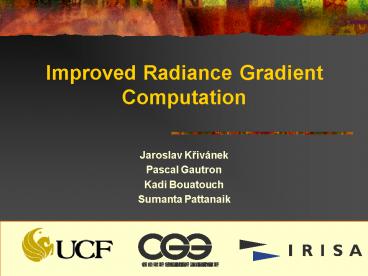Improved Radiance Gradient Computation - PowerPoint PPT Presentation
1 / 35
Title:
Improved Radiance Gradient Computation
Description:
Indirect lighting on glossy surfaces. With indirect. Without indirect ... Indirect lighting on rough glossy surfaces is rather smooth: abrupt changes are rare ... – PowerPoint PPT presentation
Number of Views:57
Avg rating:3.0/5.0
Title: Improved Radiance Gradient Computation
1
Improved Radiance Gradient Computation
- Jaroslav Krivánek
- Pascal Gautron
- Kadi Bouatouch
- Sumanta Pattanaik
2
Indirect lighting on glossy surfaces
With indirect
Without indirect
3
Indirect lighting on glossy surfaces
With indirect
Without indirect
4
Problem to solve
- Illumination integral evaluation at each visible
point
5
Brute Force Approach
- Monte Carlo gathering
- For each visible point
- Slow convergence rate
Cast hundreds of rays
6
Slow Monte Carlo Convergence - Example
- 40 samples per pixel
Acknowledgement Jason Lawrence,
http//www.cs.princeton.edu/gfx/proj/brdf/
7
Slow Monte Carlo Convergence - Example
- 100 samples per pixel
Acknowledgement Jason Lawrence,
http//www.cs.princeton.edu/gfx/proj/brdf/
8
Slow Monte Carlo Convergence - Example
- 300 samples per pixel
Acknowledgement Jason Lawrence,
http//www.cs.princeton.edu/gfx/proj/brdf/
9
Slow Monte Carlo Convergence - Example
- 600 samples per pixel
Acknowledgement Jason Lawrence,
http//www.cs.princeton.edu/gfx/proj/brdf/
10
Slow Monte Carlo Convergence Example
- 1200 samples per pixel
Acknowledgement Jason Lawrence,
http//www.cs.princeton.edu/gfx/proj/brdf/
11
Observation
- Indirect lighting on rough glossy surfaces is
rather smooth abrupt changes are rare
12
Radiance Caching Approach
- Sparse sampling of indirect illumination
- Interpolation
- Based on gradients
13
Radiance Caching
Radiance Cache
Scene
Store in cache
P1
Sample hemisphere
Project to hemispherical harmonics
Lo? x BRDF(P1) x cos ? d?
Lo(P2)? x BRDF(P2) x cos ? d?
Lo(P1)
Lo(P2)
14
Problem
Reality
With radiance caching
Wrong extrapolation
Li(P1) Li(P2)
Li(P1) ! Li(P2)
15
Wrong Extrapolation
- How does Li(P) change with P?
- ( Li(P) incoming radiance at P )
- First approximation RADIANCE GRADIENT
- Our contribution
- New radiance gradient computation
16
Wrong Extrapolation
17
Corrected with the New Gradients
18
Radiance Gradients Problem Definition
Prerequisites
- Incoming radiance Li(P) representation
- Li(P) is defined over a hemisphere
- Represented using hemispherical harmonics
- Li(P) represented by a set of coefficients
Basis functions
Coefficients
19
Radiance Gradients Problem Definition
Prerequisites
- Coefficients computed with Monte Carlo quadrature
- Uniform hemisphere sampling
- Stratification
Sum over all strata
Multiplied by thebasis function
Incoming radiance from the sampled direction
20
Radiance Gradients Problem Definition
- Coefficients hemisphere sampling
- Gradients from the same hemisphere sampling
- Something like
21
Previous Work - Polygonal emitters
- Arvo 1994
- Irradiance Jacobian due to partially occluded
polygonal emitters of constant radiosity - Holzschuch and Sillion 1995
- Polygonal emitters of arbitrary radiosity
22
Previous Work - Hemisphere sampling
- Ward and Heckbert 1992 Irradiance gradients
- Specifically for irradiance
- Cosine-proportional, uniformly weighted samples
over the hemisphere - We extend this to uniformly distributed,
arbitrarily weighted samples - Krivánek et al. 2005, Annen 2004
- Radiance gradient
- Works mostly fine, except when there is occlusion
in the sampled environment - We improve quality of this
23
Gradient Computation
- Compute contribution from each hemisphere cell
- Sum it all together
24
Gradient Computation for One Cell
25
Gradient Computation for One Cell
26
Gradient Computation for One Cell
- Wall movement gt cell area changes
- Cell area change gt solid angle changes
- Solid angle change gt incoming radiance changes
27
Putting it all together
- Sum incoming radiance changes from all cells
- Use the basis functions H as a weighting factor
- Basis functions do not change with displacement
28
Results
Old gradients
New gradients - smooth
29
Results
New gradients
Old gradients
30
Results
Old gradients
31
Results
New gradients
32
Gradients for GPU-based irradiance and radiance
caching
- Hemisphere sampling GPU rasterization
- Camera position hemisphere center
- Very non-uniform density of samples over the
hemisphere - The same gradient derivation still holds (and
WORKS!).
33
Gradients for GPU-based irradiance and radiance
caching
- Irradiance caching video
- Offline irradiance caching video
- Radiance caching video castle, walt disney hall
34
Conclusion
- New translational gradient computation
- Use information from hemisphere sampling
- Based on the Irradiance Gradients by Ward and
Heckbert - Generalized to support
- Arbitrary distribution of radiance samples over
the hemisphere - Arbitrary weighting of radiance samples
35
Thank you
?
?

